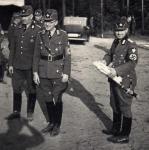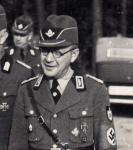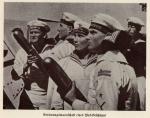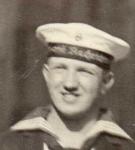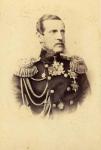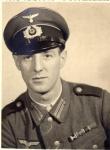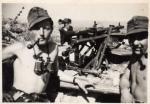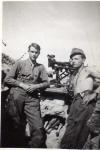-
Posts
2,143 -
Joined
-
Last visited
-
Days Won
10
Content Type
Profiles
Forums
Blogs
Gallery
Events
Store
Everything posted by Odulf
-

Netherlands Dutch Medals and Medalbars
Odulf replied to Yankee's topic in Northern European & Baltic States
Prince Heinrich von Mecklenburg, married to Queen Wilhelmina of the Netherlands. -
In October 1929 replacement of Latin by Fraktur script cap tallies was ordered.The first ships to receive the new tallies in May 1930 were the Cruisers Karlsruhe and Köln, shortly before they went on an international journey. Later the other sailing and land based units followed. Gunners o/b the cruiser Nürnberg (from:Jahrbuch der deutschen Kriegsmarine 1937).
-
An interesting photo of four sailors wearing the cap tally "Marine Nachrichenschule" in Fraktur script. On the sailor's cap, the black/white/red national cockade, which was re-instated per Vfg.v. 14.3.1933 and 15.3.1933 (MV 33, Nr.65, 67) to replace the oval gilt cap badge with the black Weimar eagle. But the German eagle on the breast and on the cap was not introduced until a year later, per Vfg. 24.3.1934.
-
When you look at the thin blue line on the silk knot you can deduct that this sailor belonged to the Marinestation der Nordsee (see my previous remarks about this matter). The portrait dates pre 1930 (Latin script), and in that time the I. Torpedobootsflottille (comprising 1. & 2. Torpedobootshalbflottille) was stationed in the Ostsee. Thus, this chap belonged to a TB of the II. Topedobootsflottille (comprising 3. & 4. Torpedobootshalbflottille).
-
Recently I received this portrait (dated 1944) of a soldier but with an interesting four place ribbon bar, comprising the NSDAP Long Service Awards in Bronze (10 yrs) and Silver (15 yrs), a combination seldom seen on the chest of a common Grenadier, and also in his button hole the ribbon of the Winter Campaign Medal. in Russia 1941/42.
-
There is a difference in the pre and post 1940 tallies, but you should feel them in your hands, the main difference is in the material of the ribbon; pre 1940: thin fine quality gold thread, well woven and hardly any relief, silk and soft (slack supple) ribbon post 1955: thick and stiff quality gold lettering,with a rough touch and much relief, stiff rayon ribbon
-

Uncategorised H.M. S. Cap tallies ?
Odulf replied to a topic in Great Britain: Militaria: Badges, Uniforms & Equipment
HMS DOLPHIN, at Fort Blockhouse, Gosport, was the RN Sumbarine Depot and Submarine School since 1905. Submarines all had individual names or numbers. -
-
-

Three medal bar (EK2, HK, Pro Ecclesia et Pontifice)
Odulf replied to Claudius's topic in Southern European & Balkan States
Very nice and scarce Uwe, thanks for sharing -

Wehrmacht System of how medals and awards were worn
Odulf replied to gdfuseddie's topic in Wehrmacht Medals, Decorations & Awards
Dr. Heinrich Doehle states in his book "Medals and decorations of the Third Reich" (1943) that Decorations with ribbons: worn on the left breast in the following order from right to left: Eisernes Kreuz 2. Klasse (1939 / 1914) Kriegsverdienst Kreuz with or without swords Ehrenzeichen für deutsche Volkspflege mit Schwertern Medaille für deutsche Volkspflege mit Schwertern Medaille “Winterschlacht im Osten 1941-42” (Ostmedaille) Kriegsverdienstmedaille Hohenzollern: Hausorden Preuβen: Roter Adler Orden III. oder IV. Klasse Preuβen: Kronen Orden III. oder IV. Klasse Österreich: Maria-Theresia-Orden Österreich: Leopold-Orden mit der Kriegsdekoration Bayern: Militär Max-Joseph-Orden Bayern: Militär-Sanitäts-Orden Sachsen: Militär-Sankt-Heinrichs-Orden Württemberg: Militär-Verdienstorden Baden: Militärischer Karl-Friedrich-Verdienstorden Preuβen: Goldene Militär-Verdienst-Kreuz Preuβen: Militär-Ehrenzeichen 1. und 2. Klasse am schwarz-weiβen oder am weiβ-schwarzem Band Österreich: Goldene Tapferkeitsmedaille Bayern: Goldene und Silberne Tapferkeitsmedaille Sachsen: Goldene Medaille der Militär-Sankt-Heinrichs-Orden Württemberg: Goldene Militär-Verdienstmedaille Baden: Militär-Karl-Friedrich-Verdienstmedaille Other German Orders and decorations for merit in the World War in precedence of their class and, with the same class, by date of award. Das Ehrenkreuz für Frontkämpfer (1935) Österreich: Die Kriegserinnerungsmedaille 1914-1918 (1932) Die Preuβischen Kriegserinnerungsmedaille 1864, das Preuβischen Kriegserinnerungs Kreuz 1866, die Deutsche Kriegsdenkmünze 1870-1871 Österreich: Kriegsmedaille Die Südwestafrika-Denkmünze, Kolonial-Denkmünze, China-Denkmünze Schlesier Adler, Kärnter Kreuz (1919), Tiroler Kriegserinnerungsmedaille (1928) Die Rettungsmedaille am Bande Dienstauszeichnungen der Wehrmacht (Österreichischen Militärdienstzeichen) Other State decorations and awards of the NSDAP showing the higher grades first or if within the same grade level the earliest date of the award received takes precedence. Deutsche Olympia-Ehrenzeichen Die Medaille zur Erinnerung an den 13. März 1938 Die Medaille zur Erinnerung an den 1. Oktober 1938 Die Medaille zur Erinnerung an die Heimkehr des Memellandes Das Deutsche Schutzwall-Ehrenzeichen (1939) Die Deutsche Olympia-Erinnerungsmedaille Das Ehrenzeichen des Deutschen Roten Kreuzes Orders and decorations of former German States' rulers in the higher classes or if within the same class level the earliest date of the award received takes precedence. Foreign Orders and decorations in the proper sequence of their receipt. -
Hard to imagine now, that these insignia were rejected/neglected when I started collecting (some 45 yrs ago); they cost next to nothing (no one had a clue about the organisation, branch or structure) and the obscure black/blue/grey/bottle green uniforms were rejected and tossed aside as rags. The same treat for Luftschütz, Police, RAD, DRK, Eisenbahn, and other uniformed organisations - we had so much to choose from and so much to learn, but there was no information and an overkill on caps, uniforms and (genuine) badges! Besides, prices were low, as were our wages...
-
To my information, RAF uniforms were issued to Australian Airmen in the UK as a replacement/surplus for the dark blue uniforms which were issued to the men Australia, before they were shipped to the European Theatre, when there were worn out. This, I was told by Australian veterans I have met in England when I visited RAF museums as member of a living history group.




